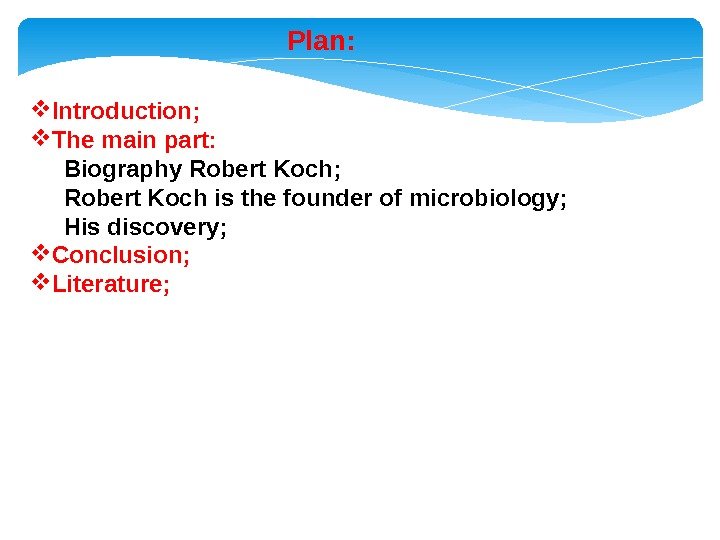Prepared by: Zhanbolatova A. J. 229 -GMF Cheched











ghanbolatova_alybina_229.pptx
- Размер: 2.6 Мб
- Автор:
- Количество слайдов: 10
Описание презентации Prepared by: Zhanbolatova A. J. 229 -GMF Cheched по слайдам
 Prepared by: Zhanbolatova A. J. 229 -GMF Cheched by: Mukhametzhanova J. A. Semey
Prepared by: Zhanbolatova A. J. 229 -GMF Cheched by: Mukhametzhanova J. A. Semey
 Plan: Introduction; The main part: Biography Robert Koch; Robert Koch is the founder of microbiology; His discovery; Conclusion; Literature;
Plan: Introduction; The main part: Biography Robert Koch; Robert Koch is the founder of microbiology; His discovery; Conclusion; Literature;
 Introduction Microbiology — industry (section) general biology that studies the life and development of microorganisms in their unity with the environment. This science studies the properties of micro-organisms and the processes that they cause in the microorganism and various environmental objects.
Introduction Microbiology — industry (section) general biology that studies the life and development of microorganisms in their unity with the environment. This science studies the properties of micro-organisms and the processes that they cause in the microorganism and various environmental objects.
 Koch, Robert (1843 -1910)- German bacteriologist. Born Dec. 11, 1843 in Clausthal near Hanover. He studied at the University of Gottingen, where in 1866 received his doctorate in medicine. During the Franco-Prussian War, he served as a military surgeon.
Koch, Robert (1843 -1910)- German bacteriologist. Born Dec. 11, 1843 in Clausthal near Hanover. He studied at the University of Gottingen, where in 1866 received his doctorate in medicine. During the Franco-Prussian War, he served as a military surgeon.
 In 1878 he published the results of experiments on the cultivation of Staphylococcus Koch, the causative agent of wound infections, and made first described under the microscope observation of the microorganism isolated from infected wounds. In 1882, Koch announced the discovery of the bacillus that causes conjunctivitis (the so-called Koch’s bacillus — Weeks), and presented at a meeting of the Berlin Physiological Society article about the causative agent of tuberculosis.
In 1878 he published the results of experiments on the cultivation of Staphylococcus Koch, the causative agent of wound infections, and made first described under the microscope observation of the microorganism isolated from infected wounds. In 1882, Koch announced the discovery of the bacillus that causes conjunctivitis (the so-called Koch’s bacillus — Weeks), and presented at a meeting of the Berlin Physiological Society article about the causative agent of tuberculosis.
 It formulated the well-known requirements, based on which we can say with a certain relationship of the disease microorganism (Koch’s postulates): 1) the microorganism must be identified in all cases of the disease, and all the symptoms of the disease should be explained by the number and distribution of microbes; 2) the microorganism is to be obtained in the culture in a pure form; 3) when infected cultured microorganism experimental animal shall occur at the latest relevant disease; 4) the microorganism is to be obtained from an infected animal.
It formulated the well-known requirements, based on which we can say with a certain relationship of the disease microorganism (Koch’s postulates): 1) the microorganism must be identified in all cases of the disease, and all the symptoms of the disease should be explained by the number and distribution of microbes; 2) the microorganism is to be obtained in the culture in a pure form; 3) when infected cultured microorganism experimental animal shall occur at the latest relevant disease; 4) the microorganism is to be obtained from an infected animal.
 With some modifications, these postulates are true today. By 1883 -1884 is the publication of yet another classic work of Koch — the opening of cholera and how it is transmitted. This success has been achieved as a result of Koch studying cholera outbreaks in Egypt and India. In 1883, he announced the creation of a vaccine against anthrax.
With some modifications, these postulates are true today. By 1883 -1884 is the publication of yet another classic work of Koch — the opening of cholera and how it is transmitted. This success has been achieved as a result of Koch studying cholera outbreaks in Egypt and India. In 1883, he announced the creation of a vaccine against anthrax.
 Koch not only enriched the doctrine of pathogens major discoveries, but also created many of the most important methods. For example, he introduced the practice of aniline dyes, proposed the use of microscopy and immersion system Abbe condenser, developed a method of culturing microorganisms in the biological fluids and solid nutrient media, introduced the practice became a classic method of fractional crops. Koch died in Baden-Baden, May 28, 1910. Conclusion
Koch not only enriched the doctrine of pathogens major discoveries, but also created many of the most important methods. For example, he introduced the practice of aniline dyes, proposed the use of microscopy and immersion system Abbe condenser, developed a method of culturing microorganisms in the biological fluids and solid nutrient media, introduced the practice became a classic method of fractional crops. Koch died in Baden-Baden, May 28, 1910. Conclusion
 Literature 1. Микробиология/Под ред. Ф. К. Черкесс. — М. : Медицина, 1987. — 512 с. 2. Основы микробиологии, вирусологии и иммунологии: Учебник: А. А. Воробьев, Ю. С. Кривошеин, А. С. Быков и др. ; Под ред. А. А. Воробьева, Ю. С. Кривошеина. — 2 -е изд. , стер. — М. : Издательский центр Академия, 2002. — 224 с.
Literature 1. Микробиология/Под ред. Ф. К. Черкесс. — М. : Медицина, 1987. — 512 с. 2. Основы микробиологии, вирусологии и иммунологии: Учебник: А. А. Воробьев, Ю. С. Кривошеин, А. С. Быков и др. ; Под ред. А. А. Воробьева, Ю. С. Кривошеина. — 2 -е изд. , стер. — М. : Издательский центр Академия, 2002. — 224 с.


